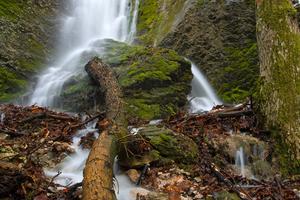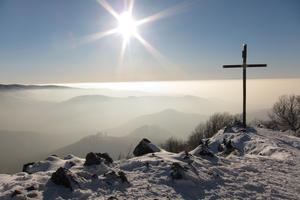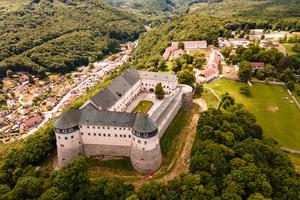You have access to this premium content thanks to ING Hubs Slovakia, the expert hub of global banking.
This article was published in the latest edition of our Bratislava City Guide, which can be obtained from our online shop with Spectacular Slovakia travel guides.
The bigger the better? Absolutely not. In the case of the countryside surrounding Bratislava, “small” is not only beautiful, it is positively great.
The seemingly flat silhouette of the Small Carpathian mountains can easily be overlooked: there are no monumental hills, no deep valleys, no obvious ready-made attractions; just a strip of green somewhere on the horizon. But then you actually take a closer look and the featureless strip suddenly comes alive with the most vivid colours and incredible diversity. Just pick a map and you will discover big treasures hidden in a small package.
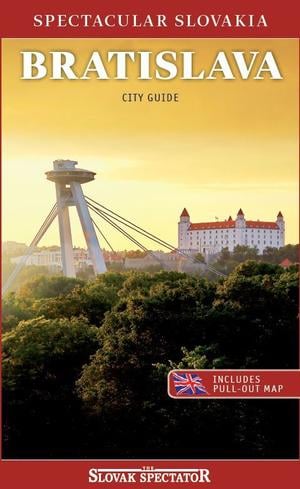 Lost in Bratislava? Impossible with this City Guide! (source: Spectacular Slovakia)
Lost in Bratislava? Impossible with this City Guide! (source: Spectacular Slovakia)
Names can sometimes be misleading. With their length of approximately 100 km, width of up to 15 km and a maximum altitude of 768 m, the Small Carpathians are definitely not among the biggest mountain ranges. But what makes them so appealing is the rich diversity of attractions they offer. In this relatively small area there are abundant unique flowers and spectacular panoramas. There are serene forests and popular dams; cosy valleys and rocky hills. You can visit ancient ruins and remote outlook towers, or ride a cable-car. All of this is usually in comfortable walking distance from each other, and connected by a network of well-marked hiking trails. With a map, a few words of advice, or even just a slightly adventurous soul you have endless possibilities at hand. And all right on Bratislava’s doorstep.
Hiking trails
Hiking spots in Malé Karpaty
Tourist map (sk.mapy.cz)
City hiking in Bratislava
Popular hills
Devínska Kobyla (lookout tower)
Other spots
Villa Rustica - the remnants of an ancient Roman building are located on the Veľká lúka meadow between Devínska Nová Ves and Dúbravka Technické sklo
Železná studienka (Iron Spring, park)
Marianka
Pajštún (castle ruins)
Svätý Jur (wine)
Pezinská Baba
Plavecký hrad (castle ruins)
Plavecké Podhradie
Smolenice Castle (www.kcsmolenice.sav.sk)
Ostrý Kameň Castle (ruins)
For more information about Bratislava see our Bratislava City Guide.
Only a few steps from a Bratislava city bus stop, you can completely forget about civilisation. After visiting Devín Castle, follow the yellow trail that will lead you through the forests and meadows. After 4 km you will reach Sandberg, which, several thousand years ago, was a seabed and has subsequently yielded some rich paleontological finds. Although most eyes will naturally be drawn to the views over Austria – occasionally the Alps are visible on the horizon – do not forget to look around your feet. In spring in particular, the meadows change colour to yellow and violet thanks to several rare plant species, such as pheasant’s eye (Adonis vernalis) and prairie crocus (Pulsatilla).
For those in a more meditative mood, you can also reach Marianka (30 min by bus from the Main Bus Station in Bratislava), the oldest Slovak pilgrimage site from where you can delve into deep beech and oak woods. A two-hour stroll will bring you to Biely kríž, an important crossroad of hiking and biking trails, where you’ll find a remarkable bar offering a small range of drinks and snacks, usually a spectacular soup and always an unforgettable atmosphere.
From Biely kríž make a short and sombre detour to Sakrakopec, where there is a plantation of 82 birch trees, each of which represents one life lost in what remains the worst air crash in the history of the former Czechoslovakia.
You can end your trip in Rača, with numerous public transport possibilities (direct links to the city centre), or descend to Železná studnička. Once best known for its spa, this romantic valley is now a very popular trip destination with comfortable paths and lots of places for barbeques. It is ideal for a leisurely stroll, and there is also a picturesque cable-car from Železná studnička to Kamzík area. During holidays and weekends, a bus service number 43 goes deeper into the forest to Kačín, a clearing with a gamekeeper’s lodge and a cosy pub, Lesanka. You’ll often find tramps playing folk and country songs here.
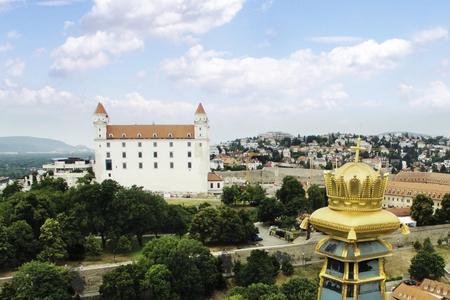
The Small Carpathians offer many more places where you can seemingly enter a totally different world. You can sample fresh sheep cheese, for instance, at the bio-farm Príroda, near Stupava, after a pleasant walk among their domestic animals. Alternatively, you can drink hot chocolate in the intimate atmosphere of the mountain chalet Korenný vrch at Pezinská Baba, a mountain pass especially popular with hikers, mountain bikers, skiers and cross-country skiers.
Castles in the hills
If you want to submerge yourself in history, visit one of the numerous castles or castle ruins. Pajštún, Plavecký hrad or Ostrý Kameň castles all demand a slightly steeper ascent, but you will be rewarded with spectacular views. Alternatively Biely Kameň or Dračí hrádok require most work from your imagination to picture the original appearance of these ruins.
You’ll get a clearer idea of how the places used to look by visiting Červený Kameň and Smolenický zámok, both of which are excellently preserved and can make a perfect interruption to a hiking trip. Meanwhile, if the 13th century isn’t quite ancient enough for you, then don’t miss Neštich, the site of a former fortified settlement above the village of Svätý Jur, which dates from the 9th century, or Villa Rustica, the remnants of an ancient Roman building on the Veľká lúka meadow between Devínska Nová Ves and Dúbravka. It dates from the 1st century AD.
Of course, the oldest treasure here is nature - even if it is often strangely overlooked. “Yes, there is no mountain pine here, nor mountain goats and the mountain height does not exceed a three-digit number, but it does not mean that there is nothing interesting here,” says Vladimír Lukačovič, who treats the Small Carpathians as a second home. “I definitely recommend visiting Klokoč in June, when the showy mullein (Verbascum speciosum) is in bloom.”
It is possible to spend as much time as you like exploring the region, and for a good full-day hike, follow the blue markers from Plavecké Podhradie to the ruins of Plavecký hrad, then continue through to Báborská hill. From there, head to Klokoč hill, noting the unique flowers, and up to Sedlo Uhliská. From there a red trail will lead you to Vápenná, a rocky hill with a small outlook tower. After approximately six hours walking, a yellow trail will guide you back to Plavecké Podhradie.
The Small Carpathians are small from the outside but big from within. Do not hesitate to wake up the adventurous spirit, take a map and go. “The whole Small Carpathians are surrounded by villages, therefore it is not a big problem if you get lost,” says Lukačovič. “Within an hour or two you can get from the ridge to the closest village. So nothing stands in the way of exploring unknown regions.”



